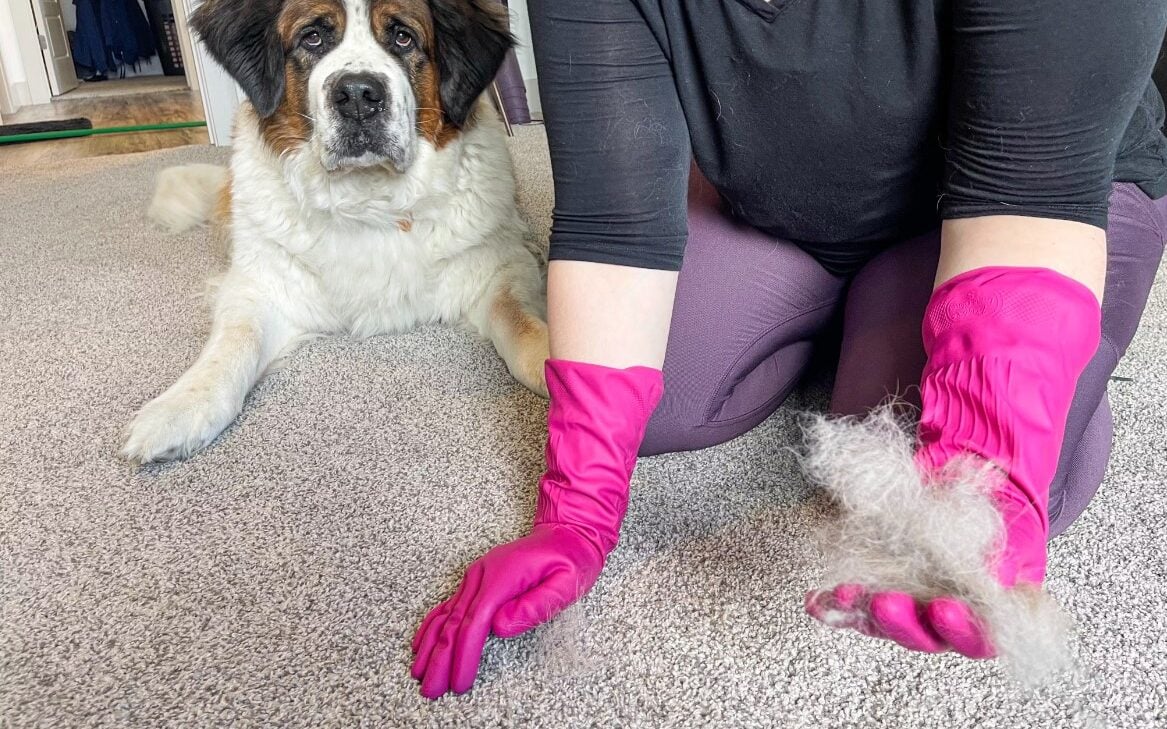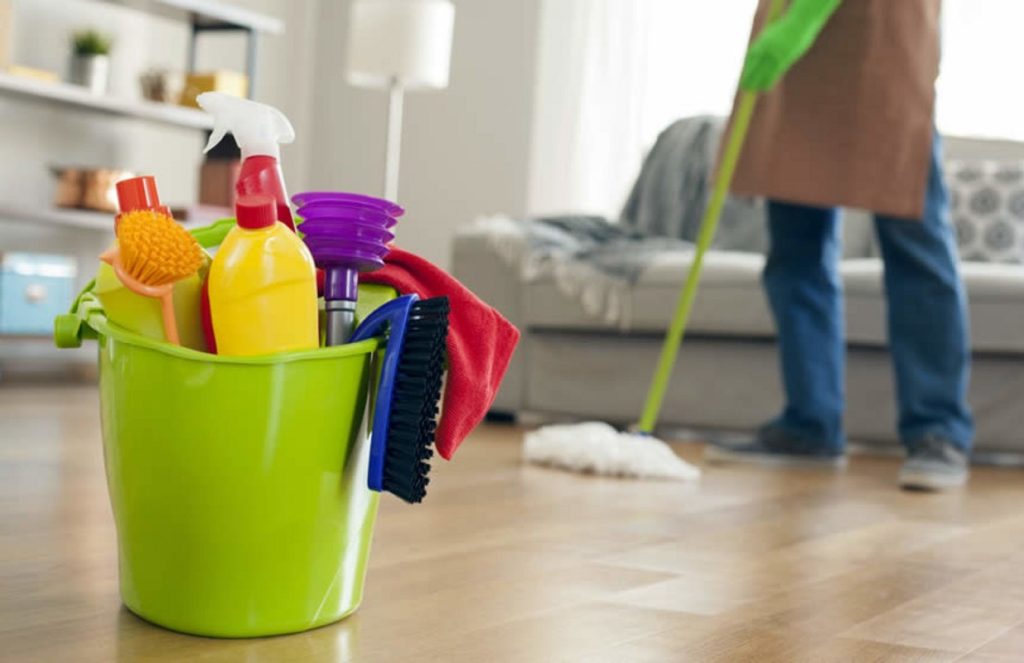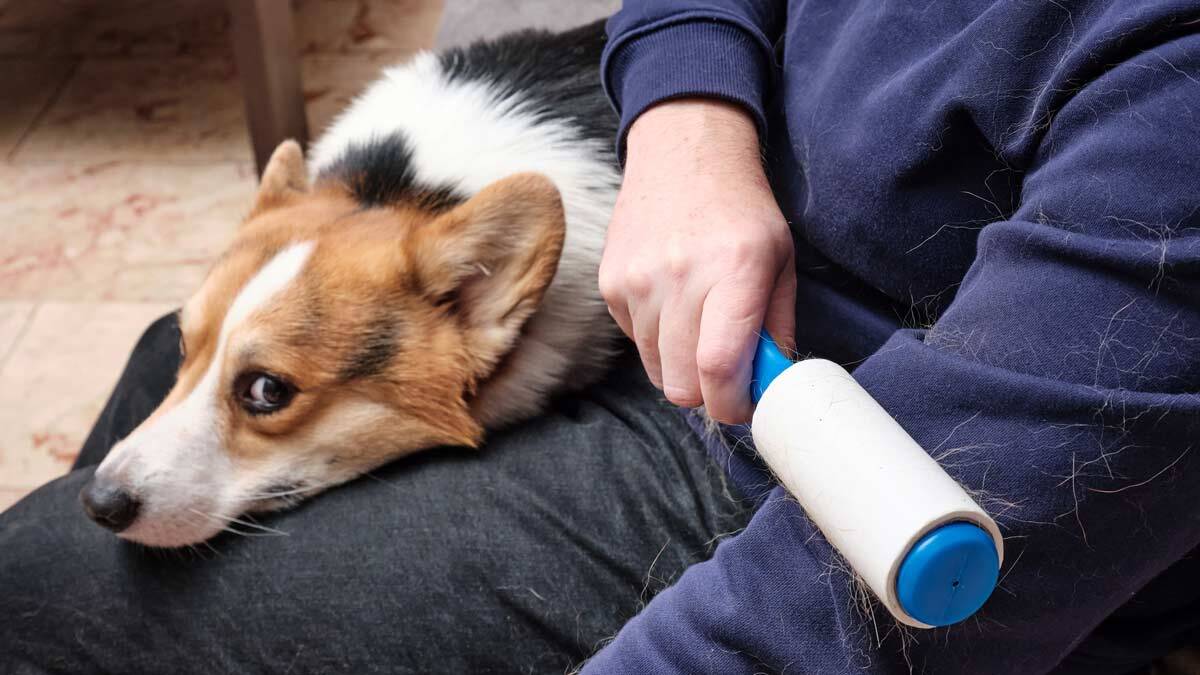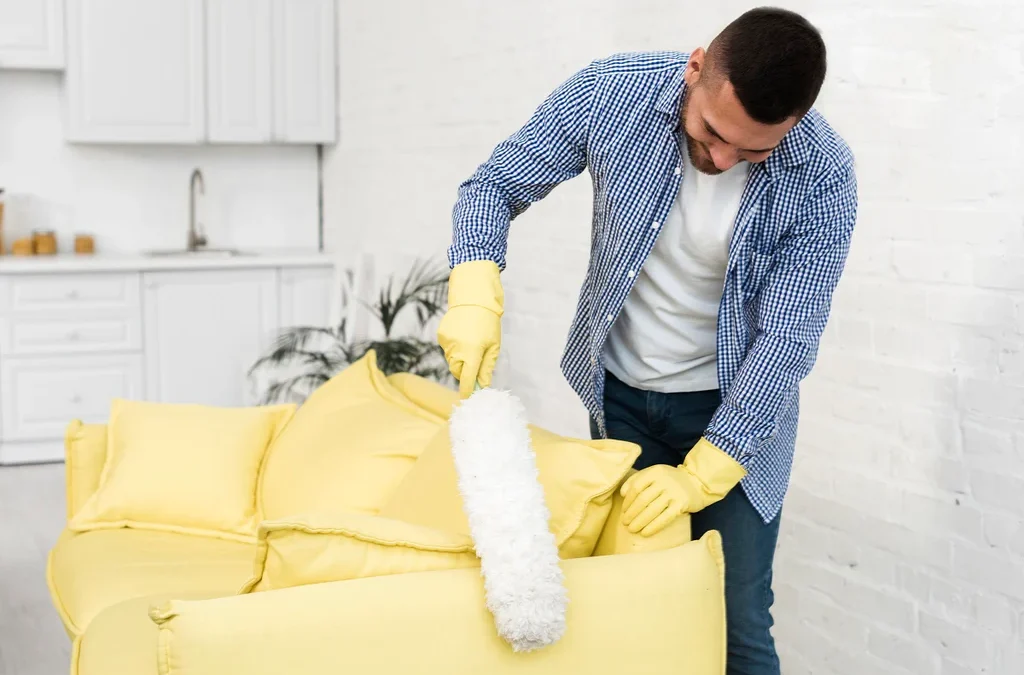If you share your home with a furry friend like I do you know that dog hair finds its way onto every surface—especially the couch. No matter how often I vacuum or brush my pup those stubborn hairs seem determined to stick around. It’s a constant battle to keep my furniture looking clean and inviting.
I’ve tried countless tricks and tools to tackle this hairy problem. Over time I’ve discovered a few reliable methods that actually make a difference. If you’re tired of seeing dog hair clinging to your couch and want simple solutions that work you’re in the right place.
Common Challenges of Dog Hair on Couches

Common-Challenges-of-Dog-Hair-on-Couches
Dog hair embeds deeply into couch fabrics, especially microfiber and corduroy, making removal difficult. Static electricity increases cling, causing strands to stick tightly. Hair accumulates in crevices and along seams, often outpacing the capacity of standard vacuum attachments.
Frequent contact between dogs and couches spreads hair consistently, even when I brush my pet daily. Allergens also build up with hair particles, which may contribute to discomfort for sensitive visitors. Some cleaning tools fail to reach tight spots or pick up finer hair.
I track the types of challenges across fabric types and pet habits to highlight the scale and complexity involved:
| Challenge Type | Description | Example Cases |
|---|---|---|
| Embedded Hair | Strands lodge in fibers, resisting vacuuming | Microfiber, chenille sofas |
| Static Cling | Hair sticks via static charge | Dry winter or synthetic mats |
| Accumulation Zones | Hair collects in seams and beneath cushions | Armrest joints, seat creases |
| Allergen Buildup | Dander and hair mix, elevating allergen presence | Guests with sensitivities |
I encounter these obstacles regardless of the frequency of routine cleaning or grooming routines. My experience matches documented observations in households with high-shedding breeds, as reported by the ASPCA and AKC. I notice that certain cleaning tools—like rubber brushes and lint rollers—struggle to dislodge tightly woven hair, and regular vacuums often miss deeply embedded strands, especially after a week of daily dog use.
Preparation Before Cleaning

Preparation-Before-Cleaning
Effective preparation makes dog hair removal from my couch faster and more thorough. I clear all cushions and objects, exposing every section where hair tends to accumulate.
Gather the Right Tools and Supplies
I gather tools proven to dislodge and collect embedded dog hair across couch surfaces:
| Tool | Description | Best Use Case |
|---|---|---|
| Vacuum (upholstery tool) | Extracts hair from deep within fabric | Routine cleaning and stubborn hair |
| Rubber gloves (dampened) | Static friction lifts loose hair into clumps | Quick manual removal over large areas |
| Lint roller (pet-specific) | Sticky sheets pick up hair on surface | Daily touch-ups and small zones |
| Rubber squeegee | Rakes fabric, gathers clumps for easy pickup | High-shedding zones and textured fabric |
| Damp sponge/pumice stone | Pulls embedded hair when compatible with fabric | Spot treatment on tough fibers |
I check my couch’s care label before using any damp method or specialty tool to avoid damage.
Safety Tips for Protecting Your Couch
- I always check manufacturer cleaning instructions before using water, friction, or cleaning agents.
- I test wet tools or solutions on an inconspicuous spot to assess color reaction or damage risk.
- I avoid harsh chemicals—if I use diluted fabric softener to loosen hair, I verify compatibility first.
- I use gentle, even motions that protect upholstery, especially on delicate fabrics like velvet and microfiber.
| Safety Step | Action Taken | Purpose |
|---|---|---|
| Check cleaning instructions | Read label/manual | Prevent unwanted damage |
| Spot test tools/methods | Small hidden area | Confirm fabric safety and compatibility |
| Avoid harsh chemicals | Use water/diluted softener | Minimize risk of fading or breakdown |
| Gentle strokes | Light, slow motions | Extend life of fabric and seams |
Effective Methods to Remove Dog Hair from Couch
Removing dog hair from a couch relies on choosing techniques matched to hair volume, couch fabric, and cleaning frequency. I combine several methods for maximum results, as each excels in different situations.
Using Lint Rollers and Sticky Tape
I quickly remove surface dog hair from my couch with lint rollers and sticky tape. Pet-specific lint rollers, which use stronger adhesive than standard types, pull both visible and embedded hair from fibers. For cushions, corners, or curtains, I sometimes use masking tape as a sticky alternative, but I avoid applying too much pressure to reduce fabric residue or damage. Pressing and rolling or patting tape over hairy areas collects most loose hair for easy disposal.
| Tool | Best For | Caution |
|---|---|---|
| Lint Roller | Surface and embedded hair | Replace sheets often |
| Sticky Tape | Cushions, fabrics, curtains | Avoid residue, test on hidden spot |
Vacuum Cleaner Techniques
I use a vacuum with an upholstery attachment for deep, regular dog hair removal. The suction, when combined with the right attachment, lifts hairs embedded in dense or textured couch fabrics like corduroy. I find vacuuming after lightly loosening hair with another tool—such as a glove—captures particles in seams and edges missed by rollers or tape. I repeat this weekly for best results, especially with high-shedding breeds.
| Feature | Benefit | Notes |
|---|---|---|
| Upholstery Attachment | Reaches deep and tight spaces | Regular use keeps allergens lower |
| Multiple Passes | Increases loose hair pick-up | Combine with pre-loosening for best results |
Dampened Cloth or Rubber Gloves
A damp cloth or rubber glove lifts stubborn dog hair from my couch, particularly from seams, tufts, and fabric crevices. I moisten a rubber glove (or sponge) with water, sometimes adding a small amount of diluted fabric softener, and wipe over the surface. The rubber texture or slight moisture attracts and collects hair into piles, which I easily pick up or vacuum. This tactic works well alongside other cleaning methods for hard-to-reach areas.
| Item | Best Use Areas | Key Steps |
|---|---|---|
| Damp Cloth | Seams, delicate spots | Spray lightly, wipe gently |
| Rubber Gloves | Edges, textured fabrics | Dampen and sweep in one direction |
Specialized Pet Hair Removal Tools
I add specialized tools like pumice stones or window squeegees for deeply embedded or stubborn dog hair. Gliding a clean pumice stone gently along fabric collects hair quickly. I use a window squeegee to drag across flat couch surfaces, pulling hair together for manual removal or vacuuming. I choose these tools for their textured grip and effectiveness on high-pile or woven fabrics.
| Tool | Material Target | Application Tip |
|---|---|---|
| Pumice Stone | Microfiber, suede | Light, single direction pass |
| Squeegee | Flat, woven surfaces | Short, firm strokes |
Consistent use of these methods and rotating between tools keeps my couch free of dog hair and allergens across all fabric types and usage patterns.
Preventing Future Buildup of Dog Hair

Preventing-Future-Buildup-of-Dog-Hair
Managing dog hair means more than just removing what’s loose on the couch; I use layered prevention methods so hair doesn’t pile up again as quickly. Targeting daily routines, extra coverings, and dog care keeps my upholstery cleaner for longer.
Regular Cleaning Habits
Maintaining regular cleaning habits helps me limit dog hair accumulation. I vacuum furniture and crevices at least twice weekly, wash throw blankets and cushion covers every week, and dust surfaces to minimize stray hair clinging to fabric or floating into the air. Using an air purifier with a HEPA filter captures airborne dander and fine hairs, keeping the environment fresher. These steps keep loose pet hair under control and reduce allergens for both me and my visitors.
| Cleaning Habit | Frequency | Benefit |
|---|---|---|
| Vacuuming couch | 2× per week | Reduces embedded and surface hair |
| Washing covers/blankets | 1× per week | Removes accumulated fur, easy to clean |
| Dusting flat surfaces | 2× per week | Lowers hair movement, cuts dander |
| Using HEPA air purifier | Daily | Captures airborne hair/allergens |
Using Couch Covers and Blankets
Adding washable couch covers or blankets creates a barrier between my dog and the main upholstery. I use covers that fit tightly around cushions or large, durable throws that attract and trap shed hair. These covers go straight into the washing machine, so they’re easy to clean and swap out. This approach protects delicate fabrics like linen and velvet, and I swap the covers weekly or after heavy shedding bouts, making the actual couch fabric easier to maintain and less likely to stain.
| Protective Measure | Material Example | Cleaning Method | Frequency |
|---|---|---|---|
| Fitted couch cover | Microfiber, poly | Machine wash, gentle | Weekly |
| Large blanket/throw | Fleece, cotton | Machine wash, gentle | Weekly |
Grooming Your Dog Frequently
Frequent grooming is my first defense against couch hair buildup. Brushing my dog every day during peak shedding seasons, or at least 3× per week for moderate shedders, keeps more hair in the brush and less in my living room. I use grooming tools that match my dog’s coat—slicker brushes for long hair, grooming mitts for short or sensitive skin. This habit helps with hair, skin flakes, and general hygiene, giving me fewer surprises on the furniture.
| Coat Type | Grooming Tool | Frequency |
|---|---|---|
| Long, double | Slicker brush | Daily |
| Short, smooth | Rubber grooming mitt | 3× per week |
| Curly | Metal comb | Every other day |
Combining these habits, routines, and tools supports consistently lower dog hair buildup on my couch and keeps my home environment fresher and more comfortable.
Additional Tips for Different Couch Materials
Effective dog hair removal methods vary based on couch material. I adjust my approach for fabric, leather, or faux leather to protect both the furniture and get the best results.
Removing Hair from Fabric Couches
When tackling dog hair on fabric couches, I use tools that capture loose fibers and reach deep into the upholstery. I alternate the following methods for a thorough clean:
- Vacuuming with the upholstery attachment reaches embedded hair in fibers and seams.
- Wearing slightly damp rubber gloves helps me gather clumps quickly, especially around edges.
- Using pet-specific lint rollers works well for routine cleanups between deep cleans.
- Spraying fabric softener mixed with water loosens stubborn hair for easy removal with a sponge.
- Gently rubbing a pumice stone, squeegee, or melamine sponge helps lift deeply embedded hair but I always spot-test first.
| Method | Effectiveness | Best For | Caution/Notes |
|---|---|---|---|
| Vacuum (Upholstery Tool) | High | Routine cleaning | Avoid wet vacuuming |
| Rubber Gloves (Damp) | High | Edges, fine detail | Spot test for colorfast |
| Pet Lint Roller | Moderate | Surface pickup | Use strong-adhesive types |
| Fabric Softener Spray | Moderate | Stubborn hair | Avoid over-saturation |
| Melamine Sponge | High | Deeply embedded fibers | Test on inconspicuous area |
Removing Hair from Leather or Faux Leather Couches
For my leather and faux leather couches, I prevent scratches and moisture damage by picking gentler tools:
- Lint rollers pick up hair efficiently without harming the surface.
- Dryer sheets wipe away loose hairs while controlling static cling.
- A soft brush collects loose fur without abrading the finish.
- I finish with a lightly dampened cloth for any remaining hair, careful to keep moisture minimal.
| Method | Effectiveness | Best For | Caution/Notes |
|---|---|---|---|
| Lint Roller | High | Everyday use | No adhesive residue |
| Dryer Sheet | Moderate | Static control | Avoid overuse, test for residues |
| Soft Brush | Moderate | Loose fur | Use gentle motions |
| Damp Cloth | Moderate | Final pass | Limit moisture, avoid overwetting |
Matching removal methods to the couch material lets me maintain cleanliness and preserve the couch surface.
Conclusion
Keeping my couch free of dog hair takes patience and the right approach but it’s absolutely possible. I’ve learned that consistency is key and having a few reliable tools on hand makes all the difference. By staying proactive and adapting my cleaning routine to my couch’s material and my dog’s shedding habits I’ve managed to create a more comfortable space for everyone. With these strategies in place you can enjoy your time with your dog without stressing over hair-covered furniture.
Frequently Asked Questions
Why is dog hair so hard to remove from couches?
Dog hair is difficult to remove because it embeds deeply into fabrics, clings due to static electricity, and accumulates in crevices and seams. Certain couch materials, like microfiber and corduroy, make it even tougher to dislodge, especially in homes with high-shedding breeds.
What tools are best for removing dog hair from couches?
The best tools include a vacuum with an upholstery attachment, rubber gloves, lint rollers, a rubber squeegee, and a damp sponge or pumice stone. Each tool serves a different purpose depending on hair amount and couch fabric.
How often should I clean my couch to control dog hair?
For best results, vacuum and clean your couch at least twice a week. Wash throw blankets and cushion covers weekly, and use dusters or an air purifier regularly to minimize stray hair and allergens.
Are certain couch materials easier to clean than others?
Yes. Leather and faux leather are generally easier to clean than fabric because hair does not embed as deeply. Fabrics like microfiber and corduroy can trap more hair and may require more effort and specialized tools.
Can using blankets or covers help reduce dog hair on couches?
Absolutely. Washable couch covers or throw blankets provide a barrier between your dog and the upholstery, making it easier to control shedding and clean up hair.
What can I do to prevent excessive dog hair buildup on my couch?
Regular grooming and brushing of your dog, frequent vacuuming, washing covers, and using an air purifier with a HEPA filter can all help prevent hair from accumulating on your couch.
Is it safe to use damp cleaning methods on all couch fabrics?
No. Always check your couch’s care label before using damp methods to avoid water damage or discoloration. Perform a spot test in an inconspicuous area before fully cleaning.
Do lint rollers work well on all types of couches?
Lint rollers are effective for quick surface hair removal, especially on fabric and leather couches. However, deeply embedded hair or thick upholstery may require additional tools like rubber gloves or a vacuum.
Does dog hair on couches increase allergens in the home?
Yes. Dog hair traps dander and other allergens, which can build up in couch fabric and spread throughout your home, potentially causing discomfort for allergy-sensitive individuals.
How can I remove deeply embedded dog hair from couch seams and crevices?
Use a vacuum with a crevice tool, a rubber squeegee, or a pumice stone to reach and loosen embedded hair in seams and tight spots. Follow up with a lint roller or rubber glove for best results.

